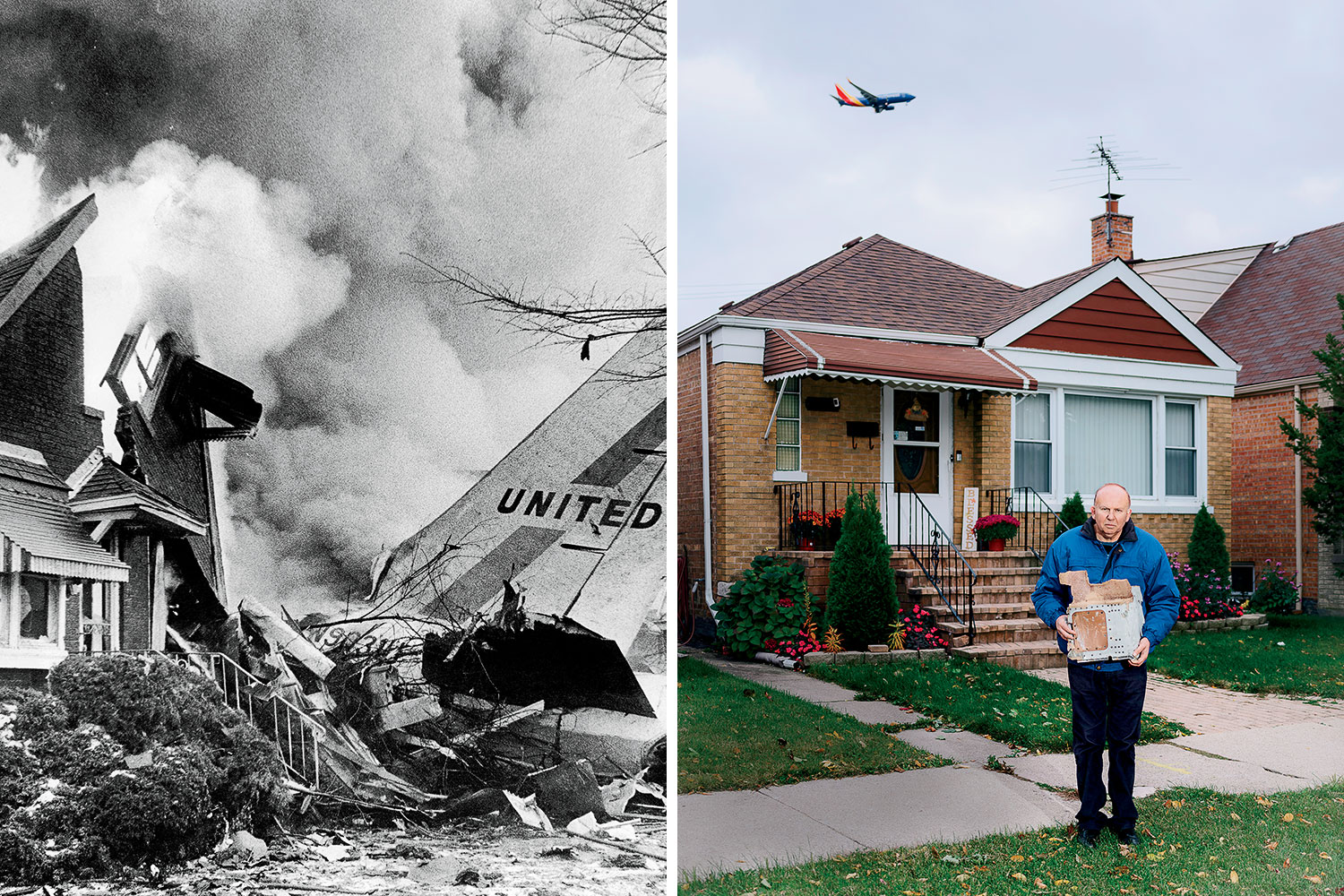For years, Evan Cotter Jr. had nightmares about December 8, 1972. That afternoon a United Airlines jet attempting to land at Midway Airport crashed into his bungalow-lined neighborhood of West Lawn, obliterating a stretch of it. Two people on the ground and 43 aboard the Boeing 737 were killed. Cotter, 13 at the time, was home when one of the wings smashed into his house. “There was rubble everywhere. It looked like a war zone,” recalls Cotter, who still lives on the block. “It was like you were on a movie set, but it was really happening.”
This is the story of how one of Chicago’s most shocking disasters unfolded on a gray and wintery day 50 years ago this month, told in the words of those who experienced it. Based largely on newspaper and TV interviews from just hours and days after the crash, this account also includes new ones Chicago conducted with Cotter, flight attendant Jean Griffin, passenger Jennifer Sherwood, and neighborhood resident Mary Morrissey.
I
IN THE AIR
As United Flight 553 approached Chicago, fog, drizzle, and light snow had cut visibility to about a mile. The aircraft had taken off from Washington National Airport at 12:50 p.m. Central time, with Omaha, Nebraska, as its ultimate destination. It was scheduled for a 2:31 landing at Midway.
With 61 aboard — 55 passengers and a crew of three pilots and three flight attendants — the 94-seat plane was about three-fifths full. Among the passengers: George W. Collins, 47, a U.S. representative from Chicago who was returning home to help organize a Christmas party for kids; Michele Clark, 29, a newly minted CBS News national correspondent who grew up in Chicago and was coming back to visit her parents; and Dorothy Hunt, 52, the wife of Watergate ringleader E. Howard Hunt, who was facing trial the following month.
At 2:19, Flight 553 — then above Gary, Indiana, roughly 25 miles southeast of the airport — was cleared to descend to 4,000 feet and directed to Midway’s runway 31L. The captain, Wendell Whitehouse, a 16-year United veteran, soon got on the intercom to address his passengers.
Marvin Anderson, a 43-year-old assistant research director at the Illinois Institute of Technology, was one of them.
Anderson:The last words the pilot said to us were, “We are at 4,000 feet and everything is going well.”
But then a warning light came on in the cockpit. The flight data recorder had stopped working. “See what’s wrong with it, will ya?” Whitehouse told his second officer, Barry J. Elder. (The cockpit audio recorder was still functioning.)
As Flight 553 drew closer to Midway, a small twin-prop aircraft was making another attempt at landing on runway 31L, having missed its first approach. To put more distance between the two planes, air traffic control asked the 737 to decrease its speed. The tower then cleared it to descend farther, but the cockpit crew was still trying to figure out what had gone wrong with the black box. Elder groused, “Christ, I can’t even find the circuit breaker for this.” He finally did and called in the problem. Only then, 35 seconds after the clearance, did the plane begin its second descent.
At 2:26, just after it crossed the “outer marker,” a beacon to signal the start of the final portion of the landing process, the plane was still at 2,200 feet — 700 feet above the recommended altitude for that point — so Whitehouse deployed the spoilers on the wings to create drag.
A minute or so later, Whitehouse spied the ground for the first time through the clouds. The plane was now at 1,000 feet. Aviation heights are expressed in terms of sea level, so that equated to about 400 feet above the city. The plane was restricted from descending any farther without the pilots being able to see the runway, so Whitehouse abruptly leveled off. In the process, though, he forgot to retract the spoilers.
Around this point, the control tower determined that the 737 and the twin-prop plane in front of it were still too close together, at less than three miles apart, and directed Flight 553 to loop around and climb to 2,000 feet for another approach. That would require more airspeed, so Whitehouse gunned the engines.
Almost simultaneously, the control yoke began vibrating noisily to warn that a stall was imminent. Whitehouse partially retracted the 737’s flaps in an attempt to reduce drag. But the plane continued to drop because the spoilers were still activated.
Anderson:I was sitting on the left side of the plane alone, near the wing and two rows from an emergency exit. I knew something was wrong because [the pilot] started to rev the engines. I thought, He’s in trouble and I’m in trouble, but I didn’t have time to think of much else. Only about five seconds after the engines were revved, the plane went into a stall.
Thirty-one-year-old Hyde Park resident Judy Sherwood, who worked as a research scientist at the University of Chicago, was traveling in coach with her two young children: Jennifer, who was about to turn 4, and 16-month-old Ari. They were coming back from visiting grandparents in Washington, D.C. Jenny held her favorite yellow blanket and a baggie filled with mini-marshmallows from her grandmother.
Judy Sherwood:The ground was coming up at me awfully fast, and I didn’t see how the pilot could get the nose up. He seemed to be trying to get power.
Near the cockpit, first-class flight attendant and 15-year United veteran Marguerite “Marge” McCausland was strapped into her jump seat.
McCausland:All I can vaguely remember is a very high-pitched, winding sound. Very high-pitched. Then you could feel like things were out of control. Then somebody screaming — I don’t know if it was me — “We’re gonna crash!”
At the far rear of the plane, Jean Griffin was also belted into her jump seat, alongside fellow flight attendant Kathy Duret. Griffin had been flying for nearly 10 years and Duret seven, but neither had experienced anything like this. Both prepared for impact.
Griffin:I guess what we were supposed to do was put our heads down on our chest and cross our arms, but it all happened so fast. Everything is falling around you, flying out of the galley compartments on the opposite side, so your instinct is to keep it away. That’s why I put my feet up on that side, but there was a windscreen there so that people who were exiting the airplane wouldn’t go anywhere but through the doorway. I put my foot through it, and when I pulled it out, my shoe came off.
At 2:27, the Midway tower radioed Flight 553 once more. But there was no response. The last words the cockpit recorder captured were “I’m sorry.” It is unclear who spoke them. At 2:28, the plane disappeared from radar view.
Jennifer Sherwood:I remember everything going dark and the roof collapsing and kind of being thrown forward in my seat — folded in half, almost.
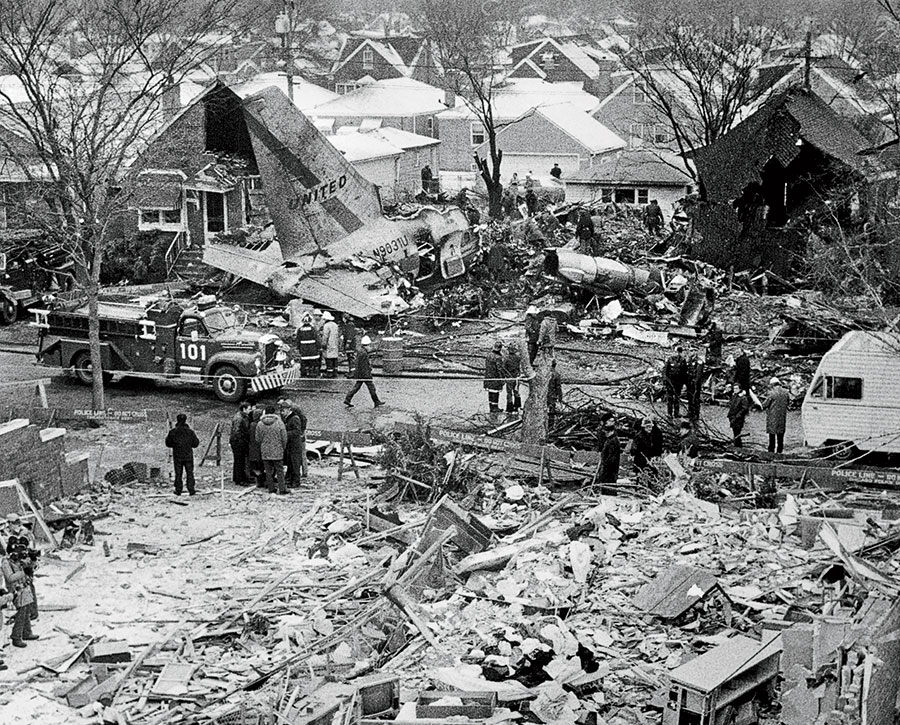
II
ON THE GROUND
Below, in West Lawn, the ground was covered with a light blanket of snow as kids walked home from Queen of the Universe, a Catholic elementary school at 71st Street and Hamlin Avenue that got out at 2:10. The other area school, Edward N. Hurley Elementary, was still in session until 2:30. Like everyone else in the neighborhood, these students were used to planes soaring overhead en route to or from Midway, a little over a mile away. But as Flight 553 first emerged from the low clouds, engines sputtering, most who saw it sensed this was different, including 12-year-old Bernadette Boyce.
Boyce:The plane was over Ridgeway [Avenue] when I saw it try to go up again, but it couldn’t. The plane was loud and its wheels were down. The wing flaps were half down and half up. It was very close to the houses.
Seventh grader Mary Morrissey, 12, was on her way home from school with three friends when they heard the troubled aircraft above.
Morrissey:On Ridgeway, there were houses the plane would have crashed into, only [the pilot] pointed his nose upward slightly. The [plane] sort of inched its way along till it got out of our sight and behind the trees. I said it was going to crash.
After scraping a roof on the south side of 71st Street, near Lawndale Avenue, Flight 553 hit the top of a tree, struck roofs on the north side of the street, and sliced through a power line.
Then it came crashing into 70th Place.
Ten-year-old Barbara Kello was walking home from school with her 7-year-old neighbor, Suzanne Sladewski, who lived on the north side of 70th Place.
Kello:I saw the plane come down and I saw a little girl in front of Suzanne’s house. I screamed for her to run, but she didn’t hear me. The plane just came down and banged and went up in flames. It hit the sidewalk on the south side of the street and hit the houses on the north side of the street. The plane missed this little girl, and she started running and I never saw her after that. I don’t know her name.
Eleven-year-old Matthew Stanis was also on his way home from school.
Stanis:We heard this big crash — like a bomb blowing up a house or something. We turned and saw big puffs of black smoke coming up. A bunch of girls playing across the street screamed and ran, and so did the guy I was walking with. All I could do was keep walking.
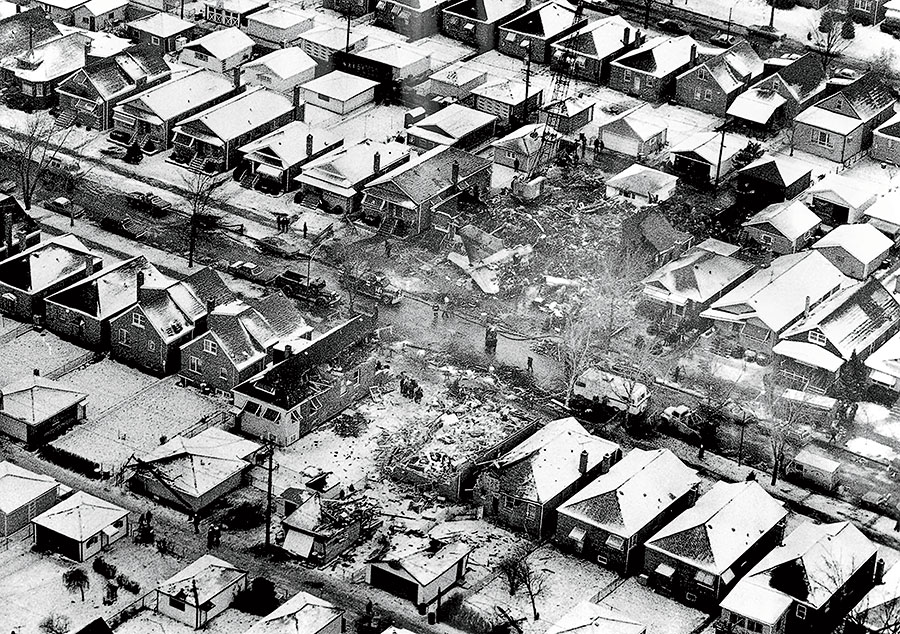
At 3718 West 70th Place, Suzanne Sladewski’s 25-year-old mother, Cindy, was lying on her living room sofa waiting for her two daughters to return from school. She had dozed off when the plane slid across the street and into her house.
Sladewski:The whole house shook. It bounced me off the couch. The first thing I thought was, Get out. I ran to the rear, but couldn’t get out there because the rear was on fire. So I came back and went through the front of the house. The whole front had been torn off by the wing of the plane. I crawled out through the rubble and debris. I remember grabbing shingle after shingle and crawling across bricks — just scrambling out. I just wanted to get out and get my kids. I knew they would be coming down the street.
Helen Pristave, the Sladewskis’ neighbor:I grabbed my coat and ran outside. I saw Cindy crawl out on her knees from under the plane. She was kneeling on the grass. She was alive, though I don’t know how she could have gotten out.
The Chicago Tribune reported that Sladewski “staggered across the street and collapsed in [Pristave’s] arms.”
Eighth grader Evan Cotter Jr., who lived at 3715 West 70th Place, had just gotten home from school.
Cotter Jr.:I was literally in my underwear in the bathroom, getting changed to go play hockey. I had opened the door to go to my bedroom, and that’s when I heard the airplane approach. It got louder and louder, and it got so loud I remember looking up at the ceiling and kind of crouching down a little bit because it sounded like it was right on top of the house. Then the next thing you know, everything in the house went horizontal. Bricks shot through walls. Our kitchen table got thrown across the room. Debris was everywhere, and there were pieces of the fuselage. There was so much smoke and dust, I could hardly even see. I remember calling out to my mother, and we ran into each other and ran toward the front of the house. It was over in two seconds, but it was horrifying. People say it sounded like a bomb going off, but it sounded like the whole neighborhood blew up.
Rosemary Cotter, Evan’s mother:It sounded like an earthquake. I saw this ball of fire and heard it hit. I ran out and headed down the street. I knew my daughter, Christine [10 at the time], was coming home from school just then. She was five minutes late leaving the school. I met her on the corner. If she had been there on time, she’d be dead now.
“We heard this big crash — like a bomb blowing up a house or something. We turned and saw big puffs of black smoke coming up. A bunch of girls playing across the street screamed and ran.”
Morrissey:My dad was a United Airlines flight mechanic, so I ran home. I remember running through the alley and into the side door of the house and saying, “It crashed! It crashed!” My father said, “What kind of plane was it?” He used to test us on the kinds of planes. “Was it a 727? 737?” I told him I didn’t know. “Was it a United plane?” I shook my head yes. So my dad ran and got his United jacket, and my mom, who had been an emergency room nurse, got her coat and grabbed some blankets and they got in the car and drove up to respond.
In all, five houses and one garage were destroyed on the 3700 block of West 70th Place. Fortunately, many of the people who lived in them were either at work or on the way to pick up their children from school. That was not the case at 3722 West 70th Place, next door to the Sladewskis. There 70-year-old Veronica Cuculich, her 37-year-old daughter, Theresa, and their German shepherd were killed when the plane hit their brick bungalow, reducing it to rubble. Cuculich’s other daughter, Dorothy, was at work at the nearby A&P grocery store when a manager informed her of the crash and drove her home. “I cried until I couldn’t cry anymore,” she would tell the Tribune in 2012, on the crash’s 40th anniversary. “I lost everything that day.”
The main wreckage area, choked by fire and smoke, spanned 250 by 90 feet. The cabin had split in two on impact, and both engines had been ripped off the plane. The mangled nose had settled in an alley after plowing through the Cuculich home. The tail section extended out of a leveled bungalow next door.
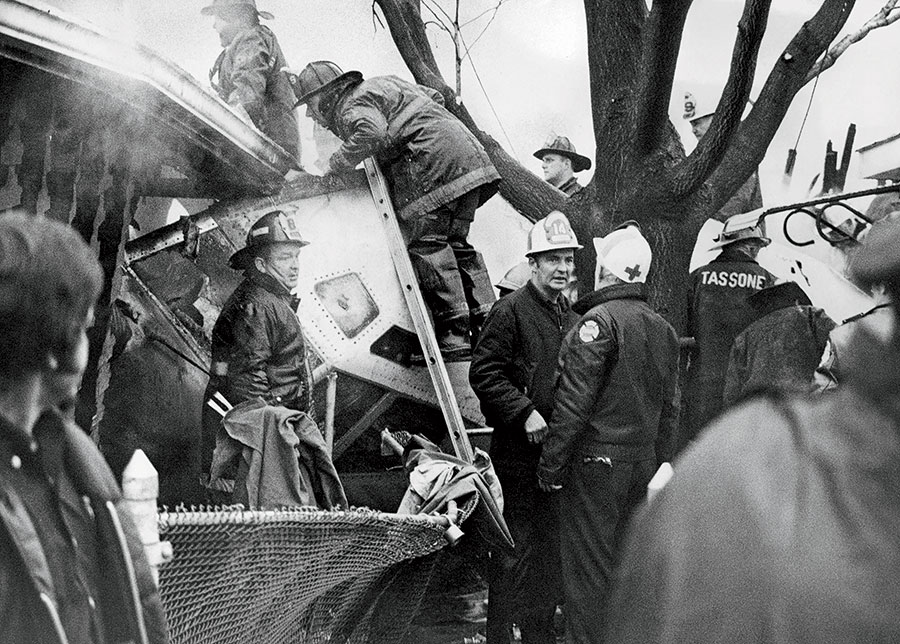
III
THE RESCUE
Once the initial shock of the crash wore off, attention turned toward helping the trapped passengers and residents, who were in danger from both the flames and the smoke of an intensifying blaze. John Blethrow of the Civil Aeromedical Institute wrote in a Federal Aviation Administration report, “Fire broke out immediately both forward [in the plane] and in the area of the left wing. The progress of fire was rapid because natural gas [likely from a severed gas line in one of the homes] was feeding it, fuel from the wings was pooling in the basement, and there was wooden debris surrounding the wreckage.”
Edward Kello Jr., Barbara’s 19-year-old brother:I jumped out of bed and heard my sister yelling that there was a fire across the alley. I looked out and flames were shooting out of three houses out there, and I couldn’t really see the houses because it was all a wall of fire.
Michael Brennan, neighborhood mail carrier:The flames were so high and the heat was so intense. I couldn’t believe anyone was alive inside [the plane]. I saw a woman’s arm hanging out of the fuselage.
Raymond Burns, off-duty police officer:I heard a woman screaming — it looked like it came from the front of the plane. A lot of people started coming on the scene, so I ran by the house that was torn apart across the street to see if we could get some of the people out of the house.
Edward Kello Jr.:Everything was black and red and hot. The flames were spreading. I saw one body on the corner of the garage, to the left of the burning homes. It was a woman, with platinum-blond hair. Her clothes were on fire, and so was a tree right next to her. One arm was dangling over the side of the garage.
Evan Cotter Jr.:By the time I finally got my clothes on and put on my coat, pandemonium was breaking out. People were running everywhere. And I literally saw people staggering out of the airplane. One guy in a trench coat had his arm around the shoulder of another guy and was dragging him. And the guy who was injured had blood coming from the middle of his body and face. My mother and I were standing there on our front steps and he actually wanted to come into the house. My mother said, “Just sit here on the front steps. The ambulance will be here in minutes.” The other guy who’d carried him just had some cuts along his forehead. He looked perfectly fine. We stood there at the site and saw two priests from Queen of the Universe saying prayers over people who were lying on the ground.
Helen Blazak, neighborhood resident:There were two young men standing on the sidewalk with their arms folded, just standing there. One had a terrible gash across his head and face, and his eye was sort of hanging out on his cheek. Another man was sitting on the sidewalk, all bloody. He didn’t have any shoes or socks, and parts of his pants were torn away and his legs were all mangled.
Edward Kello Jr.:I heard what sounded like a little girl. It was muffled: “Help. Help.” I couldn’t see where she was because of the flames. She had to be either in the nose or under the plane. I couldn’t get in [the plane]. There wasn’t much you could do with your bare hands. Another guy and I tried to pull the metal away with our hands but we couldn’t.
“Pandemonium was breaking out. People were running everywhere. And I literally saw people staggering out of the airplane. One guy in a trench coat had his arm around the shoulder of another guy and was dragging him.”
At 2:31, just two minutes after being notified of the crash, the first firefighters arrived on the scene. Scores more would soon be dispatched, joined by police officers, paramedics, and doctors and nurses from nearby hospitals. A Chicago Fire Department helicopter hovered overhead.
Inside what was left of the plane, it was dark and, at first, eerily silent. Thick, dark smoke had begun filling the air.
Griffin:The smoke was so black we couldn’t see our hands in front of our faces. I was blowing black smoke for days out of my lungs and sinuses.
Anderson:I don’t remember any real panic in the plane. I heard some screaming, but I can’t remember much noise. I could have blacked out.
Griffin:[Kathy and I] had completely different reactions. I said, “Let’s get outta here.” And she said, “Don’t get up, we’re in the air.” She certainly came around quickly.
Some of the seats had been ripped from their moorings. Debris was everywhere — galley items, blankets, personal items — and clogging the aisle. Some people climbed over the seats in an attempt to escape.
Anderson:I moved up two seats, and the fellow sitting in that seat adjacent to the emergency exit was conscious and we opened that hatch to crawl out. But we’re already inside somebody’s house. I guess we’re in two houses or something. Coming out of that window, it just burst into flames, so we actually slammed that shut and looked around.
Judy Sherwood:Jenny was screaming, “Mother, there’s a fire! There’s a fire!” I thought, My God, we’re going to die in here. But then I suppressed all that and I thought, We’re going to fight.
Judy unbuckled her seat belt, then Jenny’s and Ari’s. Jenny buried herself in Judy’s arms.
Judy Sherwood:We both fell down, hard. But I had hold of both of them and I managed to keep them away from the falling ceiling.
Ari briefly disappeared from his mother’s view.
Judy Sherwood:Some man, I don’t know who, said, “Don’t worry, I’ll get the baby out.” I could see the fire out the windows, and I dragged Jenny and somebody took her hand and led us to the back of the plane. There was a big hole there. There were hands out there to help us out. The fire was really spreading now and I was afraid it was all going to explode.
Jennifer Sherwood:Somebody pulled on me to get me out and my mom screamed for me to go. I think I didn’t want to leave her side. I remember seeing a large, dark hole. I don’t know if it was an exit door. There was a body at the doorway — I think it was a large woman, with blood on her arms. To the left of that was just tons of fire. I remember no color except for fire.
A Tribune story identified the Sherwoods’ rescuer as Joseph Stachura of 3801 West 70th Place. Stachura told the newspaper that he also helped lead two other passengers to safety.
Jennifer Sherwood:I remember going into the first floor of a house where people were extremely kind. They had this greenish carpet and gave me blankets to lie down on. They also gave me a yellow lollipop with a smiley face.
Judy Sherwood:The children didn’t have a scratch. Did all this happen?
“I saw one body on the corner of the garage, to the left of the burning homes. It was a woman, with platinum-blond hair. Her clothes were on fire, and so was a tree right next to her. One arm was dangling over the side of the garage.”
Griffin and Duret were struggling to help other passengers get out.
Anderson:I saw daylight at the rear of the plane. A stewardess was shouting to get out that way. I got back and only had to jump over an open basement beneath the plane and I was out. I saw three or four other passengers there and then the police had me in an ambulance.
Griffin:There was this little boy who had been so excited — it was probably his first airplane ride. He got on with a big smile and was sitting on the left-hand side with his father. His whole family was up close to the wing. His mother was sitting on the other side. I think she had two little girls. The little boy was dragged all the way under, I would say, 10 seats to near the last couple of rows. How he possibly could have been dragged that far, I don’t know. He was still alive, but you can imagine the damage [he had suffered]. I tried to pull him out, and I couldn’t. And then nearby, there was a woman who was standing up. Her legs were tangled in the wreckage. And I kept saying, “Is it just your leg?” I was pulling on her, trying to get her free, and I couldn’t. So there were two people that I knew I wasn’t able to save.
The two flight attendants ultimately guided nine passengers to safety.
Griffin:We went out through the door on the right-hand side, which was the galley. The [rescue] slide had been inflated into the basement of a house, and we had to step around the frame to get out. Some [people] got out over the wing [through breaks in the fuselage].
Griffin, now entirely shoeless and her hair singed by flames, and Duret walked across the snowy ground and were taken to Holy Cross Hospital, about a mile and a half away, in a police car.
Griffin:They were just crazily driving, and we had to tell them, “Slow down. We survived a plane crash and now we’re [going to be] killed in a police car on the way to the hospital.”
As rescuers carried passengers, living and dead, out on stretchers and treated the wounded, McCausland remained trapped in the front part of the plane. Somewhere close by, the flight attendant later recalled, a baby choked and cried. Then it was silent.
McCausland:I could feel parts of my body burning. I was sure I was going to die.
As she lay pinned under debris from the plane and bricks from the homes, her long black hair caked with blood, McCausland managed to yell for help. She then heard a voice call out, “Someone is alive here!” McCausland’s would-be savior soon appeared in the form of firefighter and paramedic John “Duke” O’Malley. A veteran of the Korean War and later described in one newspaper report as “a bear of a man,” he was confident and kind. “Don’t worry, honey,” he told her, “we’re gonna get you out.” She replied faintly, “OK, I believe you.” With the help of other firefighters, O’Malley began clearing away rubble.
The Reverend Robert Hagarty, pastor at Queen of the Universe Church, had arrived on the scene shortly before first responders began pouring in.
Hagarty:John took charge and worked like a maniac to save her. I prayed with Marge during the whole ordeal. She was lucky there was so much rubble on top of her because it saved her from the fire and smoke.
McCausland:[John] said, “I’m going to throw a cloth over your face, because we’re going to cut you out and I don’t want you to get burned.”
O’Malley:I had very high hopes for [Marge] because she was in such good spirits and so coherent.
Frank Hanes, Chicago Today photographer:The heat from the fire was terrific, but there were these men right in the middle of the flames trying to save a stewardess. The firemen kept a steady stream of water on her while the rescuers worked.
After about 30 minutes of intense efforts by the firefighters, O’Malley was finally able to pull McCausland from the wreckage, making good on his promise. She was the only survivor from the front of the aircraft.
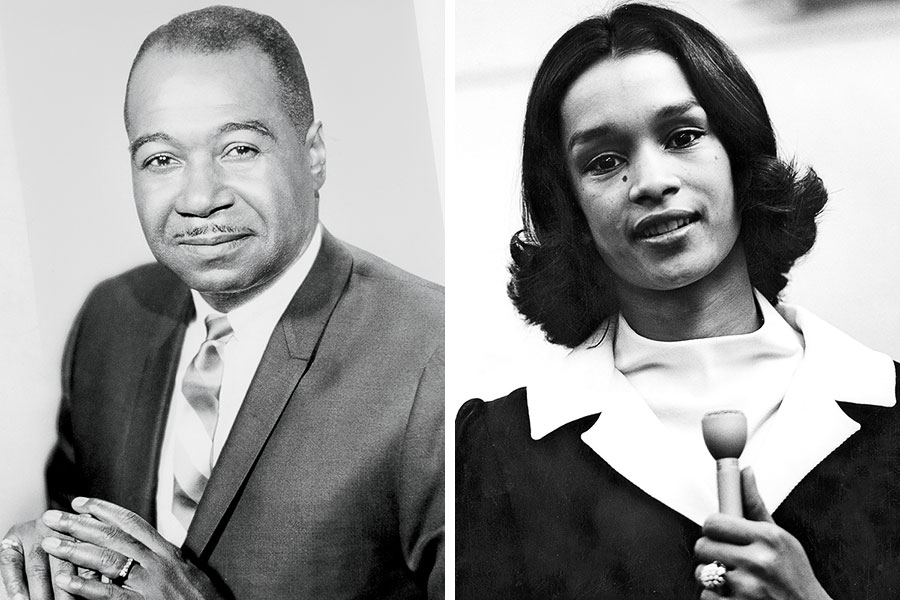
IV
THE AFTERMATH
Within 20 to 30 minutes of the crash, firefighters had extinguished the main flames, but smoke, heat, and smaller flare-ups continued for the next few hours. Large portions of both wings and the fuselage, from behind the cockpit to the rear galley door, were consumed by the fire.
O’Malley drove McCausland in his ambulance to Holy Cross Hospital, where survivors were being treated. There, Frank J. Nowak, head of the hospital’s disaster plan task force, led a veritable army of more than 175 physicians, surgeons, nurses, and aides who’d been summoned, many while off duty, in anticipation of mass casualties. They treated 17 who’d been injured, including the three flight attendants.
Griffin:When we went to the hospital, [Kathy and I] were in the emergency room trying to get phone numbers from passengers who wanted us to call their families. We were just anxious to see how many people had survived. The hospital staff did not want us there in our tattered uniforms and sent us to another room, where we were interviewed by the FBI. We thought, Why is the FBI asking about first-class passengers?
They soon learned it had something to do with Dorothy Hunt, who died in the crash. Her recovered purse contained more than $10,000 in cash. Rumors quickly spread that it was hush money connected to her husband’s crimes. Conspiracy theories sprang up and persist to this day, unproved.
By midnight, the Cook County morgue had received 43 bodies from Flight 553, including that of an 8-month-old infant. Many of the victims had to be identified by dental records since they were so badly burned. Among the deceased were all three members of the cockpit crew, Congressman Collins, and Michele Clark, the TV reporter.
McCausland spent 10 days at Holy Cross, including five in intensive care. Her injuries included third-degree burns, a broken wrist, a crushed thigh, two shattered ankles, and multiple contusions and lacerations. She was then transferred to a hospital in Fairfax, Virginia, close to her home, where she recovered for another three months. “At first,” McCausland told the Southwest News-Herald in 1973, “my family thought I would never walk again.” But she did.
Her fellow flight attendants suffered only minor injuries.
Griffin:My husband and Kathy’s husband flew to Chicago [after the crash]. When they took us to our hotel, United president Eddie Carlson called and [asked] if he could come over and talk to us. He said, “What do you ladies drink?” And we said, “Scotch.” So he and one of the vice presidents showed up with a bottle of scotch. They sat on one bed and we sat on the other bed and talked. They just wanted to know what happened and how we felt and what we were going through. I remember it as a very thoughtful gesture.
When the couples flew back to Washington, D.C., the next day, Griffin recalls, United had a car waiting for them near the runway to avoid reporters. Toward the end of December, the airline flew the two couples to Hawaii — ostensibly for some rest and relaxation, but Griffin suspects it was another attempt to avoid media scrutiny. Asleep in her Hawaii hotel one night, Griffin was startled awake by fireworks and thought, Oh, my goodness, I’m crashing again.
Griffin:I remember Marge calling [after the crash]. I was so glad to be alive and that some people had gotten out. [But] she was very angry. And I remember saying, “But, Marge, you survived. You survived.” And she didn’t want to hear that. She just wanted to say how angry she was and how frustrated, and I’m trying to be a counselor, trying to make her feel fortunate that she survived. But I guess it’s just how different people deal with traumatic events. I didn’t feel any anger — I was just relieved.
McCausland:For a long time, I was terribly angry … and then I felt lucky. You realize how fragile life is and how very quickly it can all be taken from you.
A couple of months after her life almost ended, and not the least bit enthused about United’s offer of a 9-to-5 office job, Griffin went back to work as a flight attendant — and held that role for another two decades. Duret and McCausland never returned to the job. Now 81, Griffin lives in southern Maryland. Often around December 8, she stops in at Washington National Cathedral to light a candle to commemorate the crash. Even now, recollections of that horrible afternoon can still bring tears. “You don’t think about it every day,” she says, “but the memory never goes away.”
Reunited soon after the accident, McCausland and Firefighter O’Malley kept in touch for years, occasionally visiting each other with their spouses. O’Malley died in 2011, and McCausland died five years later. Duret also died in 2016.
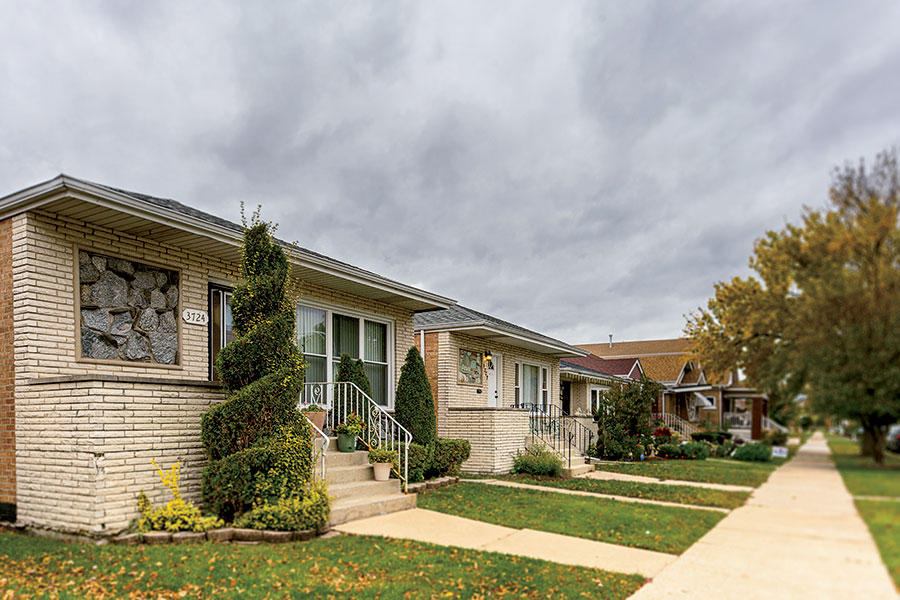
In its accident report, issued in August 1973, the National Transportation Safety Board determined that an “error-provoking environment” in the cockpit and “the captain’s failure to exercise positive flight management earlier during the approach” had caused the crash. The findings spurred the FAA to make sure pilots had proper instruction on the effects of spoilers.
In West Lawn, reconstruction efforts quickly got under way. Dorothy Cuculich (who later took the last name Dubinski) rebuilt a house on the lot where her sister and mother had been killed. McCausland returned to visit the area after nine months, remarking, “I can’t believe how fast they built it back up.”
Two years after the crash, Chicago’s Austin Middle School was renamed Michele Clark Middle School in honor of the journalist who died. Today it’s Michele Clark Academic Prep Magnet High School.
At the crash site, where airplanes continue to soar over well-tended homes and neatly trimmed lawns on their way to and from Midway, there is no statue, no plaque — nothing to indicate that something tragic and momentous happened in this quiet neighborhood so many years ago.




